Primax Electronics D51303 Bluetooth Adapter User Manual Full size BT Adapter
Primax Electronics Ltd Bluetooth Adapter Full size BT Adapter
User manual
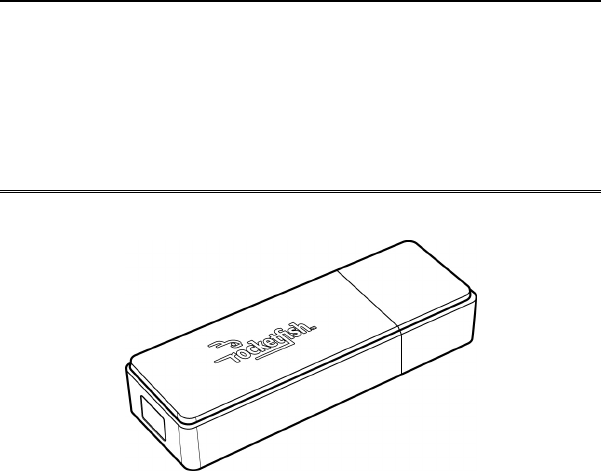
Full size BT Adapter
User’s Guide
Table of Contents
INTRODUCTION................................................................................... 1
P
ACKAGE
C
ONTENTS
......................................................................... 1
PC
R
EQUIREMENTS
............................................................................ 1
C
ONNECTING TO
PC........................................................................... 2
INSTALLING THE BLUETOOTH SOFTWARE (VISTA)................ 3
USING THE BLUETOOTH SOFTWARE (VISTA)............................ 7
CONNECTING BLUETOOTH DEVICE (VISTA) ............................. 9
INSTALLING THE BLUETOOTH SOFTWARE (XP) .................... 12
USING THE BLUETOOTH SOFTWARE (XP) ................................ 16
CONNECTING BLUETOOTH DEVICE (XP).................................. 20
UNINSTALLING THE SOFTWARE.................................................. 25
W
INDOWS
XP................................................................................... 25
W
INDOWS
V
ISTA
.............................................................................. 25
TROUBLESHOOTING........................................................................ 26

1
Introduction
Congratulations on your purchase of this high-quality Rocketfish product. Your Full-
size BT Adapter is designed for reliable and trouble-free performance.
Package Contents
USB Bluetooth adapter x 1
Installation CD x 1 (includes Bluetooth software and User’s Guide)
User’s Guide x 1
PC Requirements
Pentium processor or equivalent
At least one USB port (USB 2.0 or 1.1)
CD-ROM drive
Operating System: Windows
®
2000, Windows
®
XP with Service Pack 1 or higher,
Windows
®
Vista.
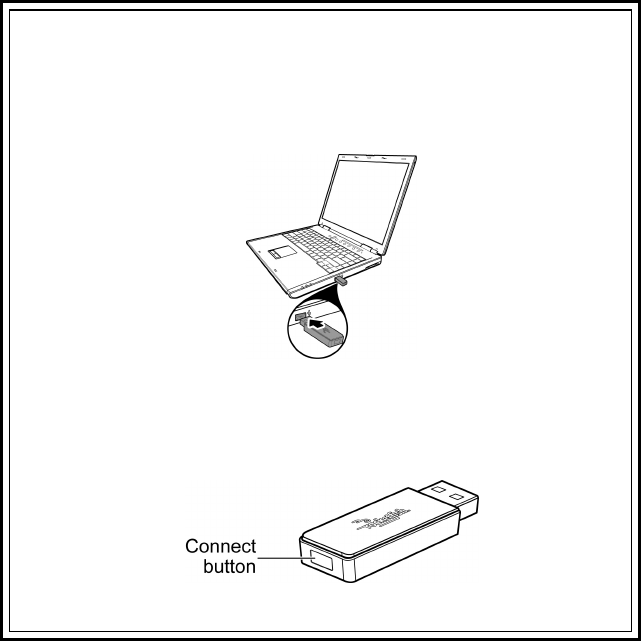
2
Connecting to PC
1. Find an available USB port on your PC.
2. Remove the cap from the adapter and plug in the Bluetooth adapter as
shown.
If your adapter does not connect automatically, press and hold the
Connect button to establish a connection.
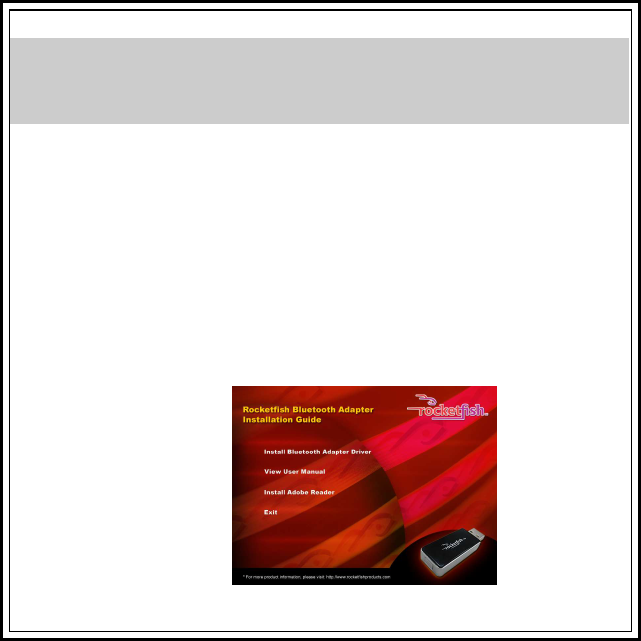
3
Installing the Bluetooth Software
(Vista)
Before installing the Bluetooth software, plug the USB Bluetooth adapter into a
USB port of your computer. If not, a warning message will appear and prompt you
to plug the USB Bluetooth adapter into a USB port during the installation.
The following procedures are based on Windows Vista operating system.
1. Insert the provided Installation CD in the CD ROM drive.
2. The Bluetooth software loads automatically. If the program does
not start automatically, open Windows Explorer, browse the Vista
folder on the CD, then double-click Setup.exe.
3. The Installation Guide screen opens. Click Install Bluetooth
Adapter to begin installation.
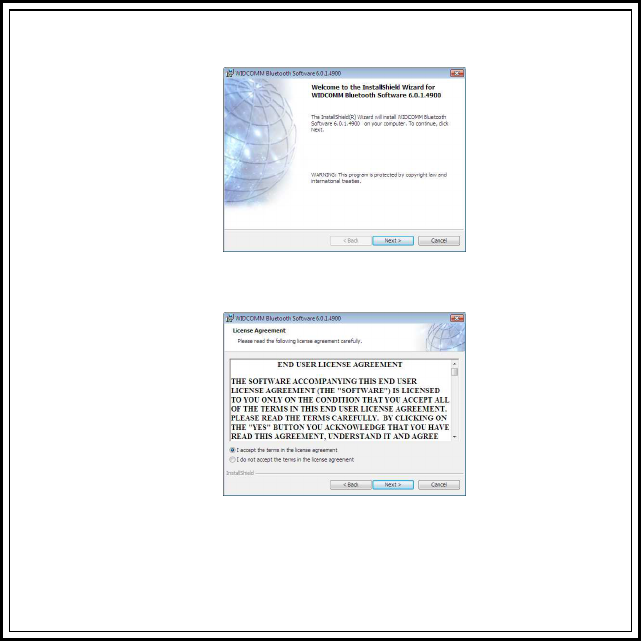
4
4. The welcome screen appears. Click Next to begin installation.
5. Read the agreement and select I accept the terms in the license
agreement. Click Next to continue.
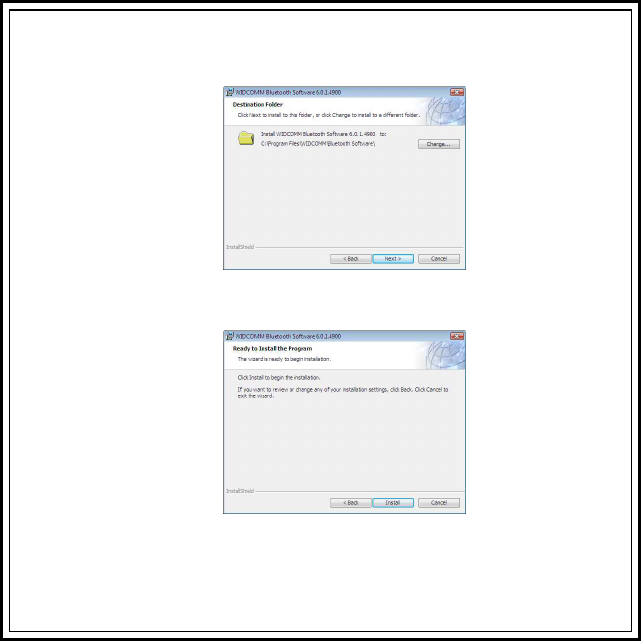
5
6. The program will be installed in the folder as shown. Click Change
to install in a different directory. Click Next to continue.
7. Click Install to start the installation. The installation may take some
time to complete.
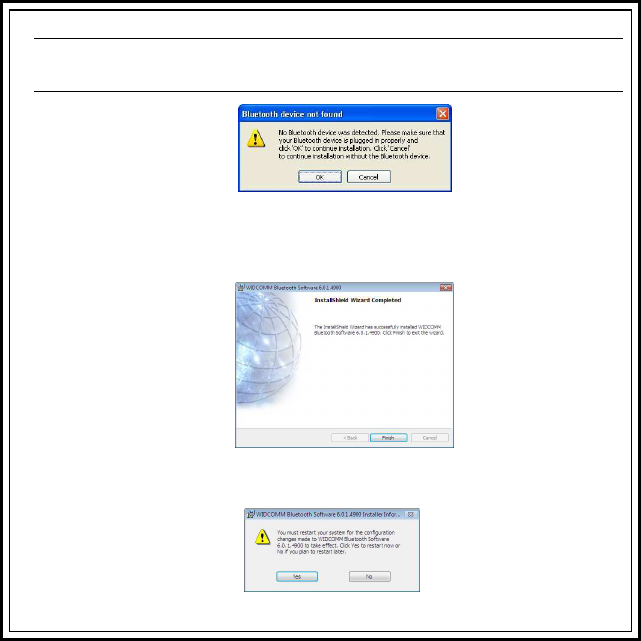
6
Note: If the “Bluetooth device not found” message appears, plug the USB
Bluetooth adapter into a USB port of your computer and click OK.
The Found New Hardware Wizard starts installing the components for the USB
Bluetooth adapter.
8. The following screen appears to indicate installation is complete.
9. Click Yes to restart your computer and for the new settings to take
effect.
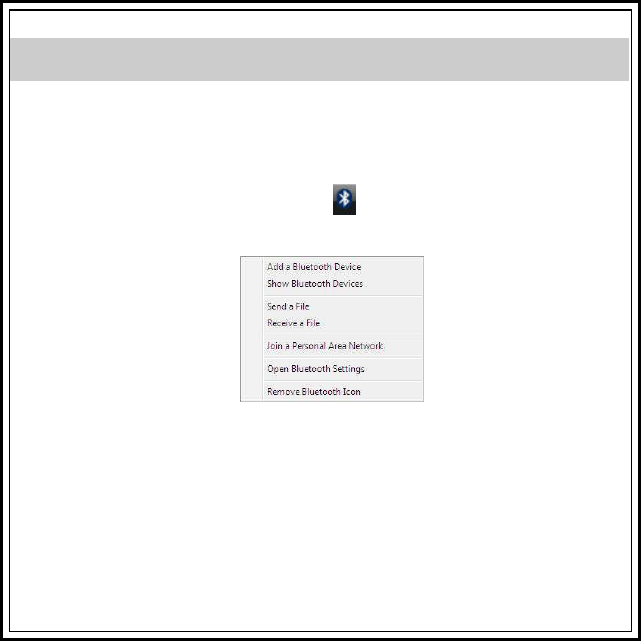
7
Using the Bluetooth Software (Vista)
After you have completed the driver and software installation and reboot your
computer, a Bluetooth icon will appear on your desktop and in the bottom right
hand corner of your desktop screen (systray). The Bluetooth icon gives you
access to the Bluetooth shortcut menu and Bluetooth Devices, for configuring
your Bluetooth settings.
Right click the Bluetooth icon to display the shortcut menu.
• Add a Bluetooth Device: Click to add a new Bluetooth device.
• Show Bluetooth Devices: Click to show all detected Bluetooth devices.
• Send a File: Click to send a file using Bluetooth File Sharing.
• Receive a File: Click to receive a file using Bluetooth File Sharing.
• Join a Personal Area Network: Click to join a private Bluetooth network.
• Open Bluetooth Settings: Click to open the Bluetooth Devices screen.
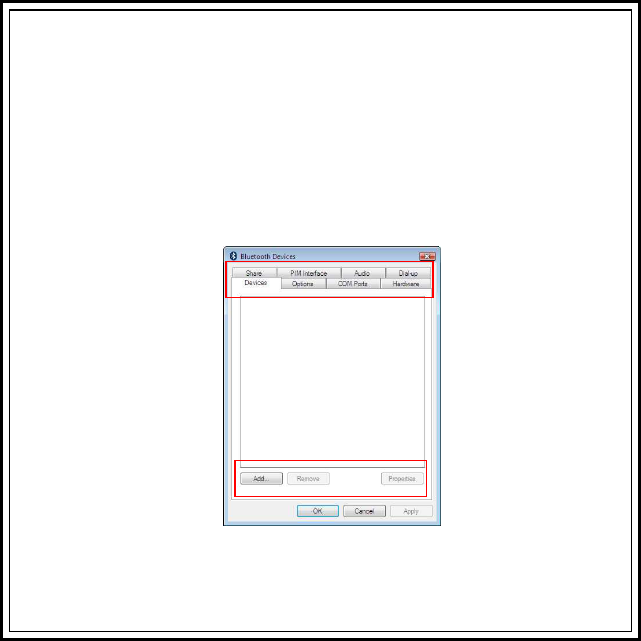
8
• Remove Bluetooth Icon: Click to remove the Bluetooth icon from the
system tray.
• Double click the Bluetooth icon for access to Bluetooth Devices.
You can manage all your Bluetooth connections and settings from the Bluetooth
Devices screen.
Use the tabs at the top of the screen to navigate the Bluetooth Devices screen.
Click OK to confirm a setting, and close the screen, click Cancel to cancel any
changes, and click Apply to confirm a setting without closing the screen.
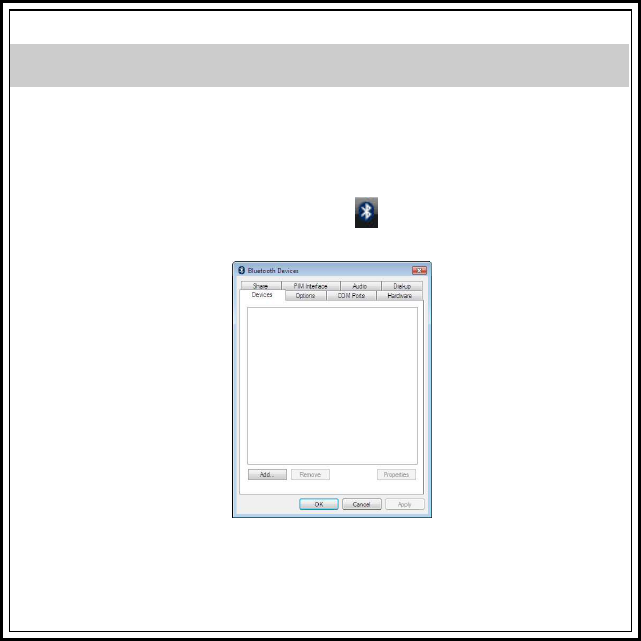
9
Connecting Bluetooth Device (Vista)
Before connecting the Bluetooth make sure that:
• You have installed and configured the Bluetooth software.
• You have plugged the Bluetooth adapter in a USB port on your computer.
1. Right-click the Bluetooth icon on the toolbar, then click Show
Bluetooth Devices. The Bluetooth Devices dialog box opens.
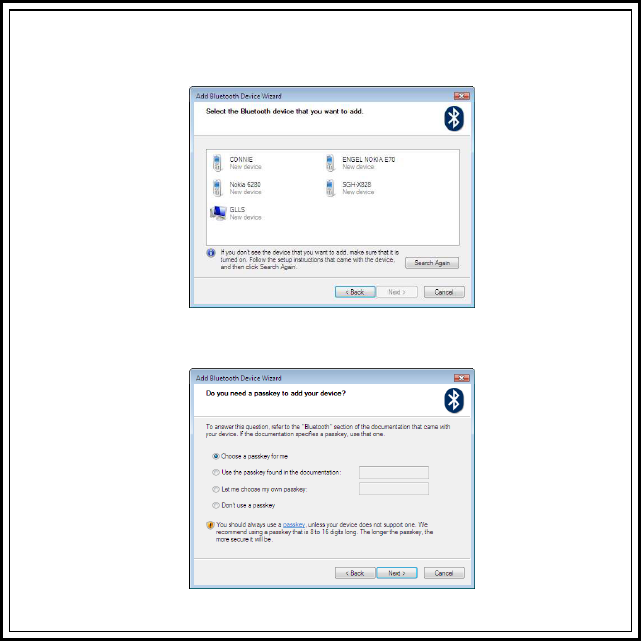
10
2. Click Add to search for Bluetooth devices. When a Bluetooth device
is found, the Add Bluetooth Device Wizard dialog box opens.
3. If more than one Bluetooth device is found, click the device you
want to connect to and click Next. The Passkey dialog box opens.
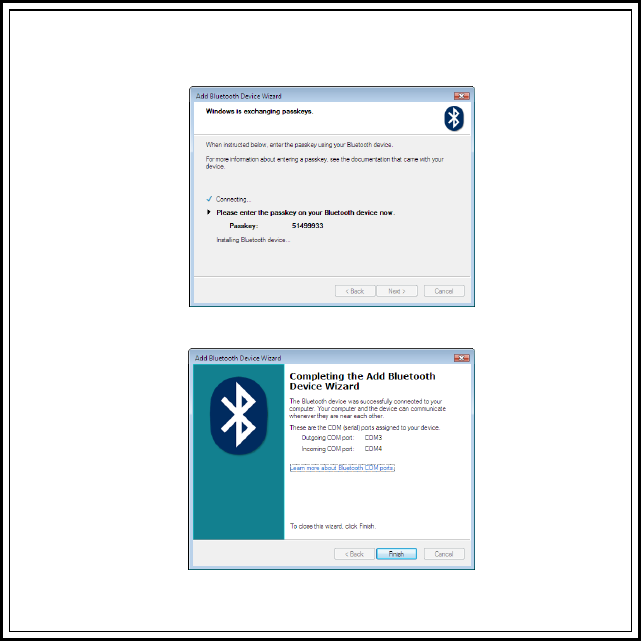
11
4. Select your Passkey option and click Next. The Exchange passkey
dialog box opens if you choose to use a passkey.
5. Enter the passkey on your Bluetooth device to start the connection.
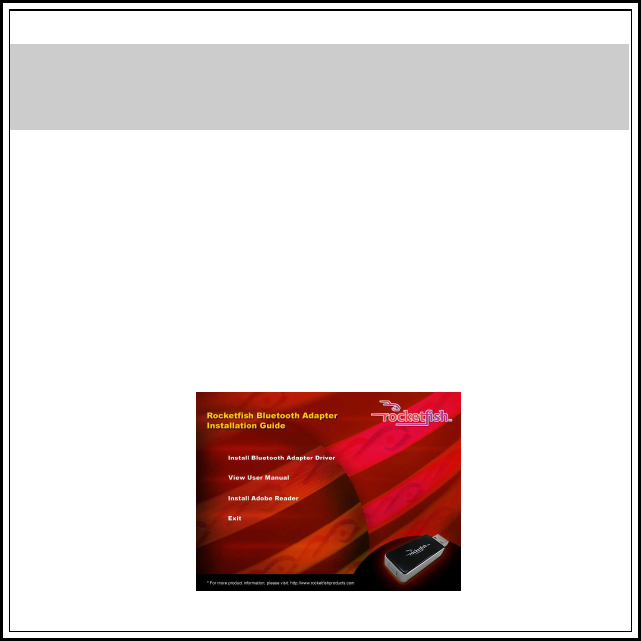
12
Installing the Bluetooth Software
(XP)
Before installing the Bluetooth software, plug the USB Bluetooth adapter into a
USB port of your computer. If not, a warning message will appear and prompt you
to plug the USB Bluetooth adapter into a USB port during the installation.
The following procedures are based on Windows XP operating system.
1. Insert the provided Installation CD in the CD ROM drive.
2. The Bluetooth software loads automatically. If the program does
not start automatically, open Windows Explorer, browse the Vista
folder on the CD, then double-click Setup.exe.
3. The Installation Guide screen opens. Click Install Bluetooth
Adapter Driver to begin installation.
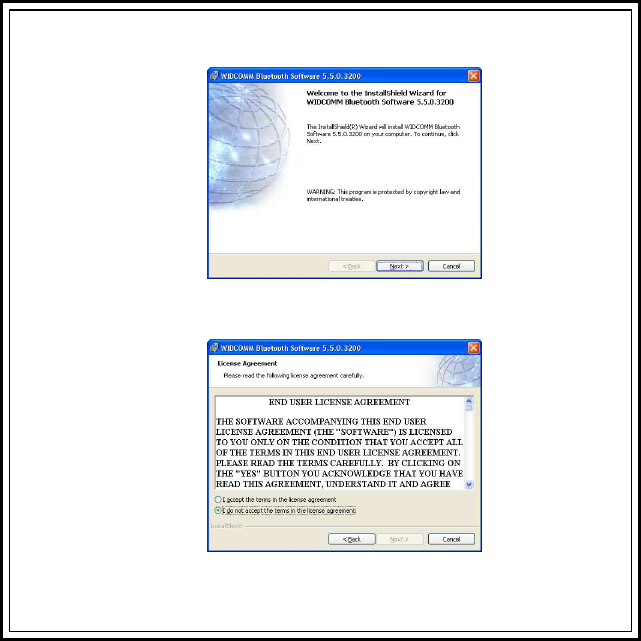
13
4. The welcome screen appears. Click Next to begin installation.
5. Read the agreement and select “ I accept the terms in the
license agreement”. Click Next to continue.
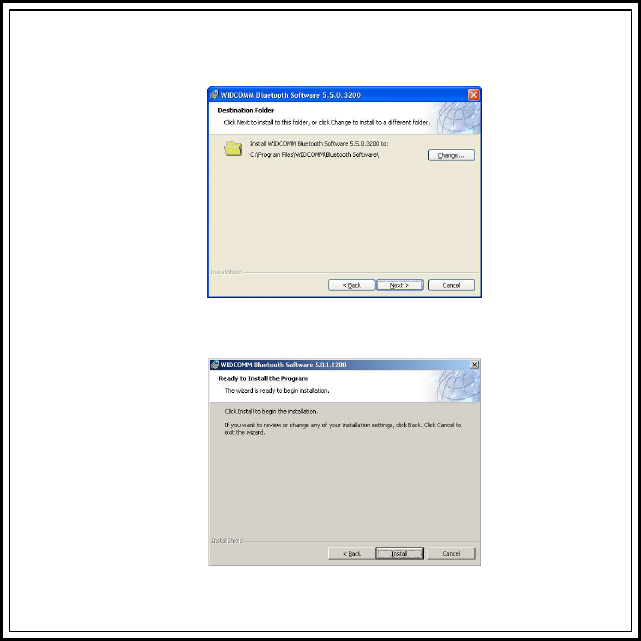
14
6. The program will be installed in the folder as shown. Click Change
to install in a different directory. Click Next to continue.
7. Click Install to start the installation. The installation may take some
time to complete.
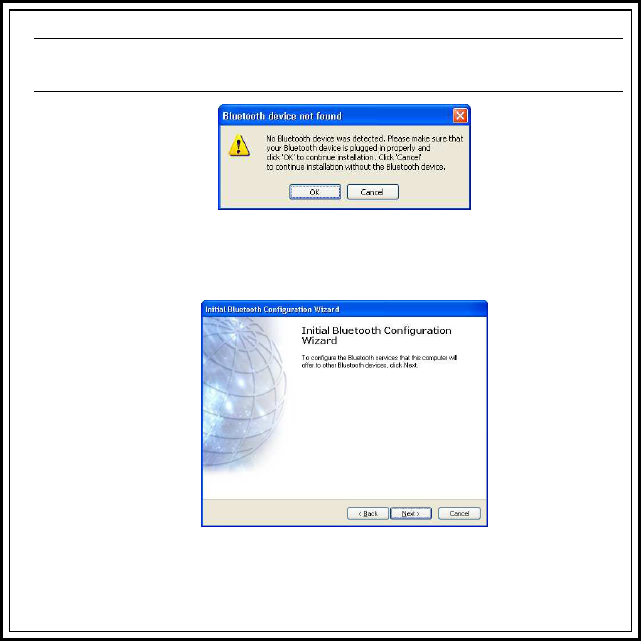
15
Note: If the “Bluetooth device not found” message appears, plug the USB
Bluetooth adapter into a USB port of your computer and click OK.
The Found New Hardware Wizard starts installing the components for the USB
Bluetooth adapter.
8. The following screen appears to indicate installation is complete.
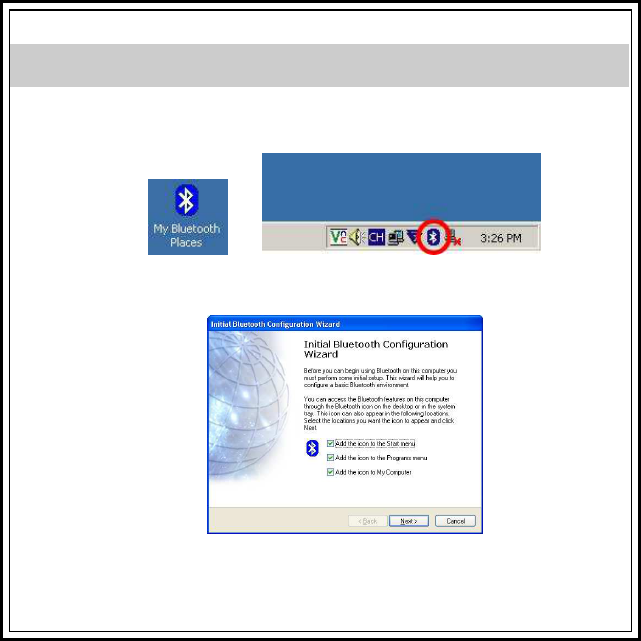
16
Using the Bluetooth Software (XP)
To start using the Bluetooth software, double click My Bluetooth Places on the
desktop or the Bluetooth icon in the system tray.
1. The Initial Bluetooth Configuration Wizard launches. Click the
locations where you want the icon to appear, then click Next.
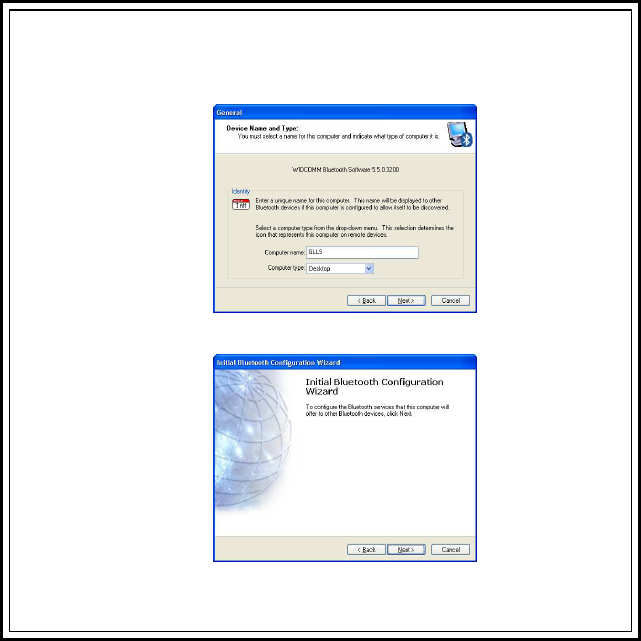
17
2. For first time users, enter a name and select either Laptop
Computer or Desktop Computer from the drop-down menu for
your computer. Click Next to continue.
3. Click Next to continue. The Service Selection screen opens.
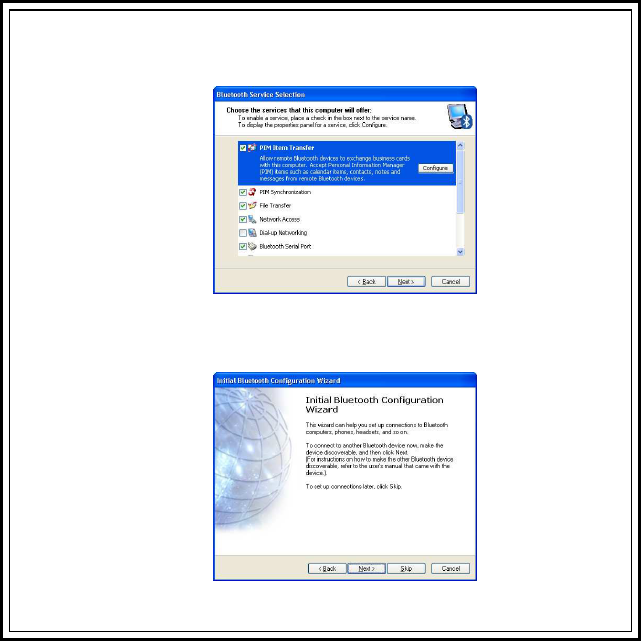
18
4. Make sure that each Bluetooth service that you want to use has a
check mark, then click Next. The connection setup screen opens.
5. If you want to set up a Bluetooth connection, make sure that the
Bluetooth device is in pairing mode, then click Next. Or, if you do
not want to set up Bluetooth connections, click Skip.
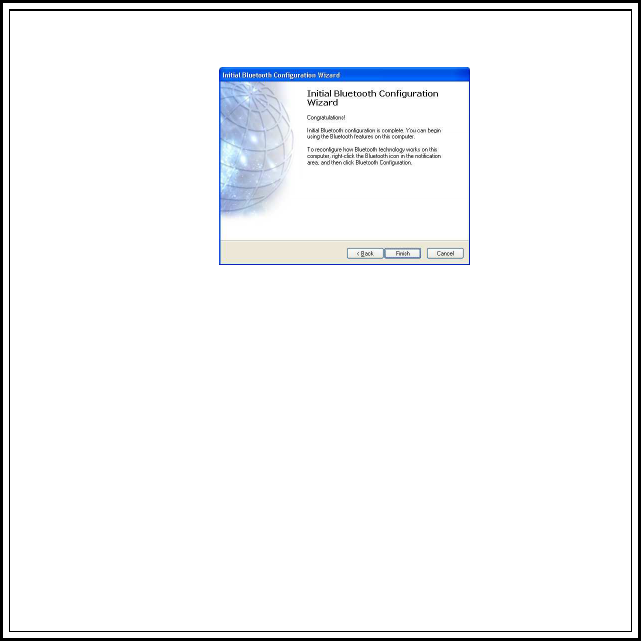
19
6. Once configuration is complete, click Finish.
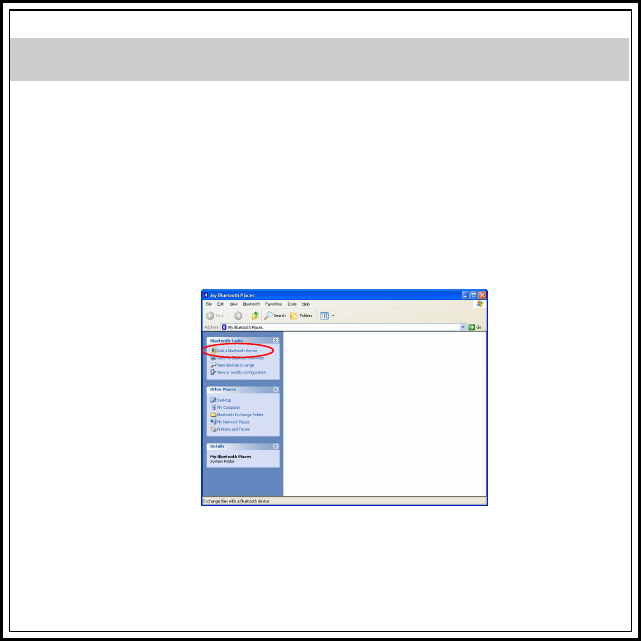
20
Connecting Bluetooth Device (XP)
Before connecting the Bluetooth makes sure that:
• You have installed and configured the Bluetooth software.
• You have plugged the Bluetooth adapter in a USB port on your computer.
To connect with the Bluetooth devices, such as printers, modems, and PDAs,
you can use the Bluetooth Set Wizard to set up a connection. Open the
Bluetooth Set Wizard in My Bluetooth Places window.
1. Click Add a Bluetooth Device to begin.
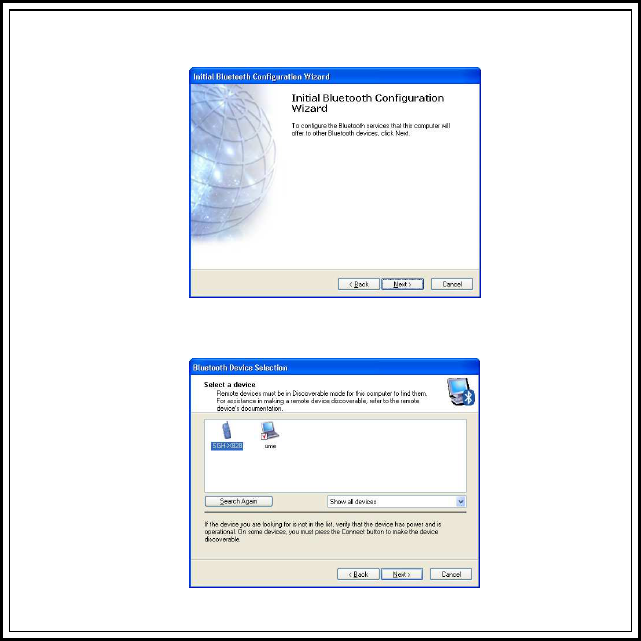
21
2. Click Next to continue.
3. The discovered Bluetooth devices are shown on the screen.
Select a device and click Next to continue.
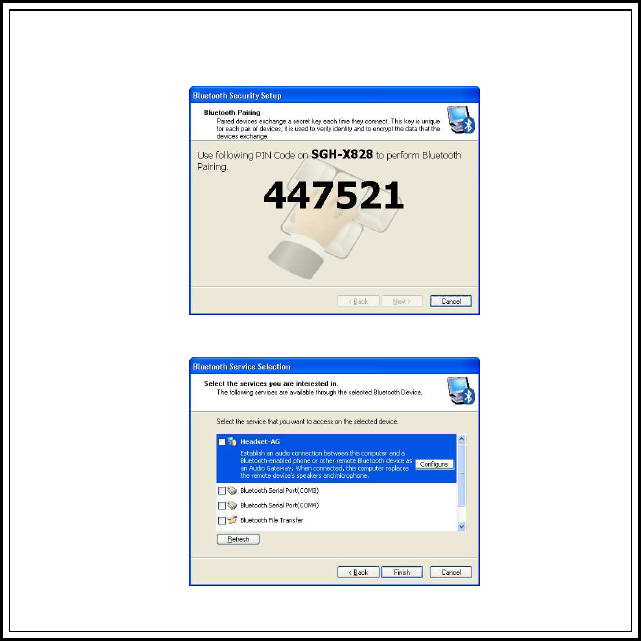
22
4. The following Security Setup screen appears. Type the digits
shown on the screen to connect the device.
5. Select the services to enable and click Next.
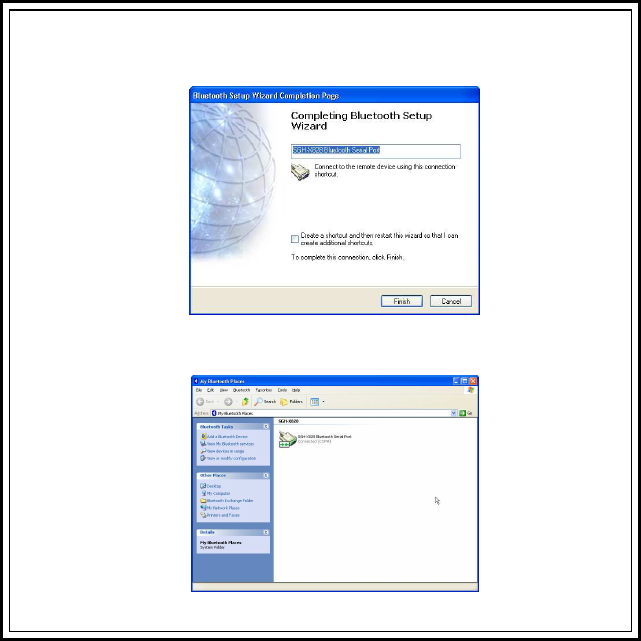
23
6. Enter the name for your Bluetooth device and choose if you
want to create shortcut and restart wizard.
7. Your Bluetooth device is now connected. Click the shortcut to
start using the device.
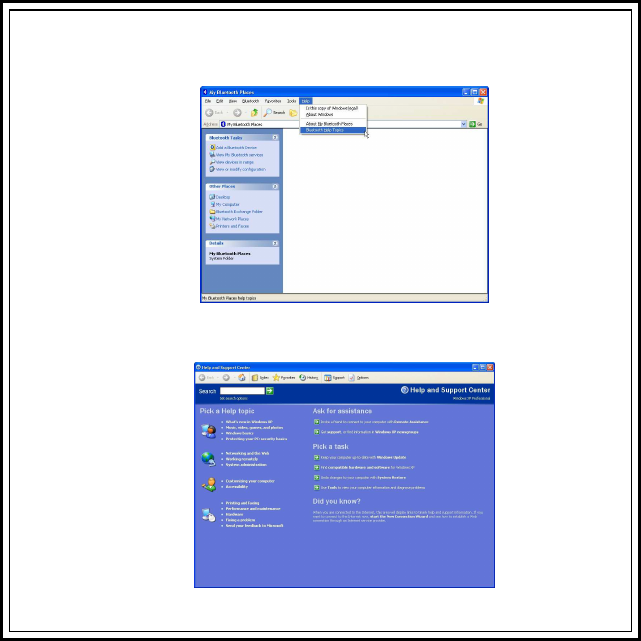
24
For detailed connection settings, refer to the Help file in the My Bluetooth Places
window. Click Help > Bluetooth Help Topics to open the Help file.
Or press F1 to open Microsoft Windows
®
XP Help and Support Center and
search for Bluetooth. You can find instructions on how to connect other devices.

25
Uninstalling the Software
Windows XP
1. Unplug the Bluetooth adapter.
2. Click Start, and then click Control Panel. The Control Panel opens.
3. Click Add or Remove Programs. The Add or Remove Programs window
opens.
4. Click WIDCOMM Bluetooth Software, then click Remove.
Windows Vista
1. Unplug the Bluetooth adapter.
2. Click Start, then click Control Panel. The Control Panel opens.
3. Under Programs, click Uninstall a program. The Program and Features
window opens.
4. Click WIDCOMM Bluetooth Software.
5. When a message asks you if you want to uninstall the software, click Yes.
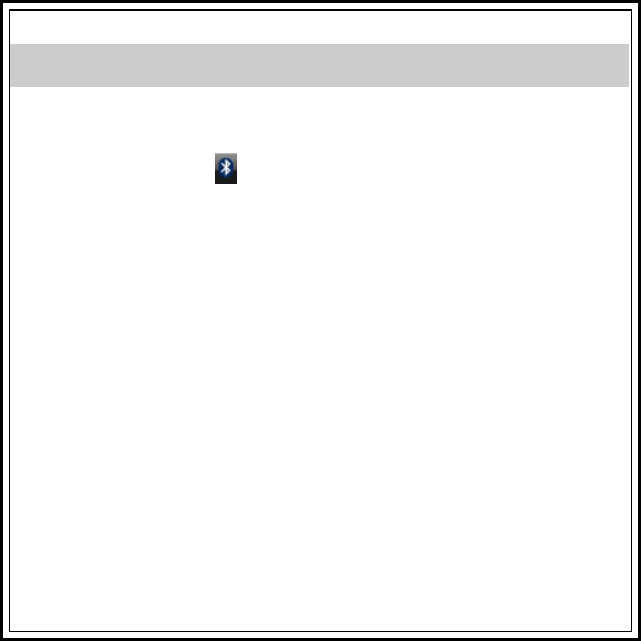
26
Troubleshooting
If you experience problems connecting a Bluetooth device:
1. Double-click My Bluetooth Places on the Windows desktop or click the
Bluetooth icon on the toolbar. The My Bluetooth Places window
opens.
2. Click Help in the menu bar at the top of the window, then click Bluetooth
Help Topics. The Bluetooth help file opens.

27
Federal Communication Commission Interference
Statement
This equipment has been tested and found to comply with the limits
for a Class B digital device, pursuant to Part 15 of the FCC Rules.
These limits are designed to provide reasonable protection against
harmful interference in a residential installation. This equipment
generates, uses and can radiate radio frequency energy and, if not
installed and used in accordance with the instructions, may cause
harmful interference to radio communications. However, there is no
guarantee that interference will not occur in a particular installation.
If this equipment does cause harmful interference to radio or
television reception, which can be determined by turning the
equipment off and on, the user is encouraged to try to correct the
interference by one of the following measures:
- Reorient or relocate the receiving antenna.
- Increase the separation between the equipment and receiver.
- Connect the equipment into an outlet on a circuit different from that
to which the receiver is connected.
- Consult the dealer or an experienced radio/TV technician for help.
This device complies with Part 15 of the FCC Rules. Operation is
subject to the following two conditions: (1) This device may not cause
harmful interference, and (2) this device must accept any interference
received, including interference that may cause undesired operation.

28
FCC Caution:
Any changes or modifications not expressly approved by
the party responsible for compliance could void the user's authority to
operate this equipment.
IMPORTANT NOTE:
FCC Radiation Exposure Statement:
This equipment complies with FCC radiation exposure limits set
forth for an uncontrolled environment. End users must follow
the specific operating instructions for satisfying RF exposure
compliance.
This transmitter must not be co-located or operating in
conjunction with any other antenna or transmitter.
IC Statement
Operation is subject to the following two conditions: 1) this
device may not cause interference and 2) this device must
accept any interference, including interference that may cause
undesired operation of the device.